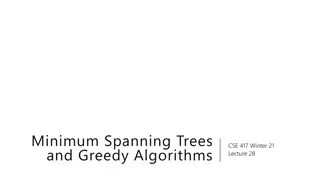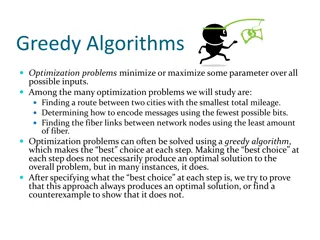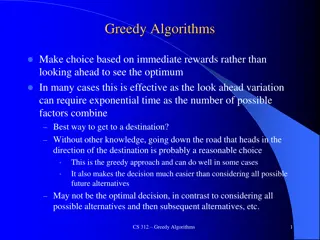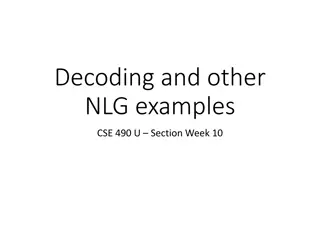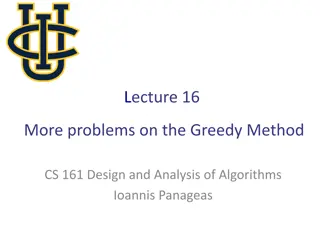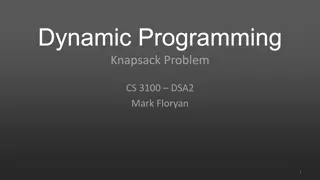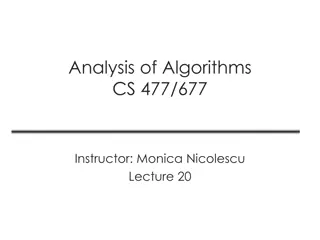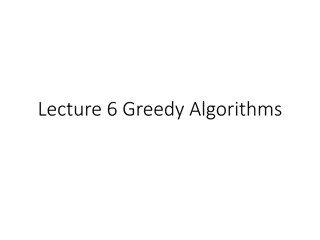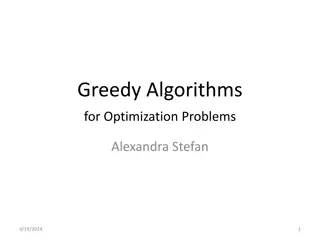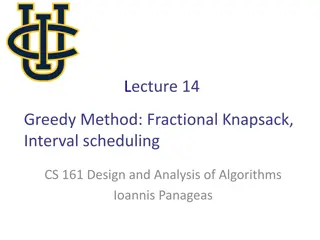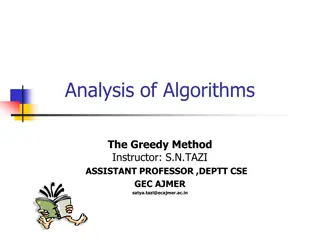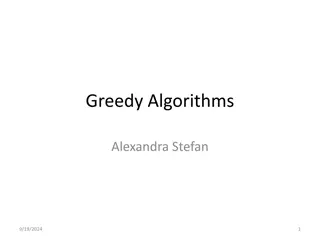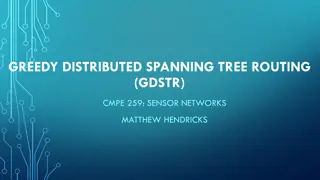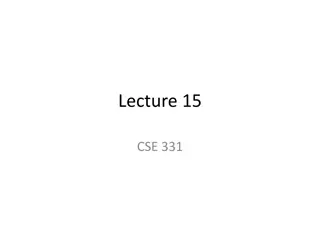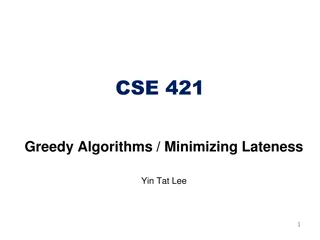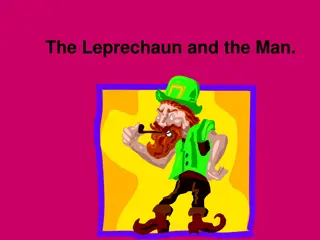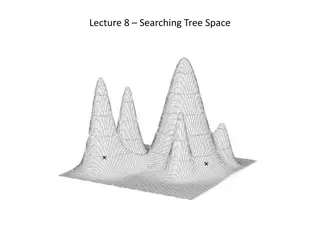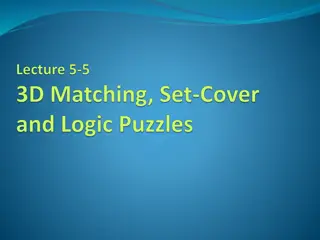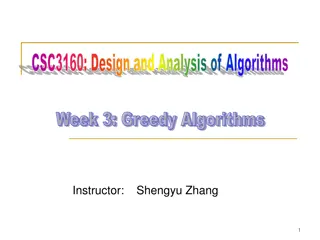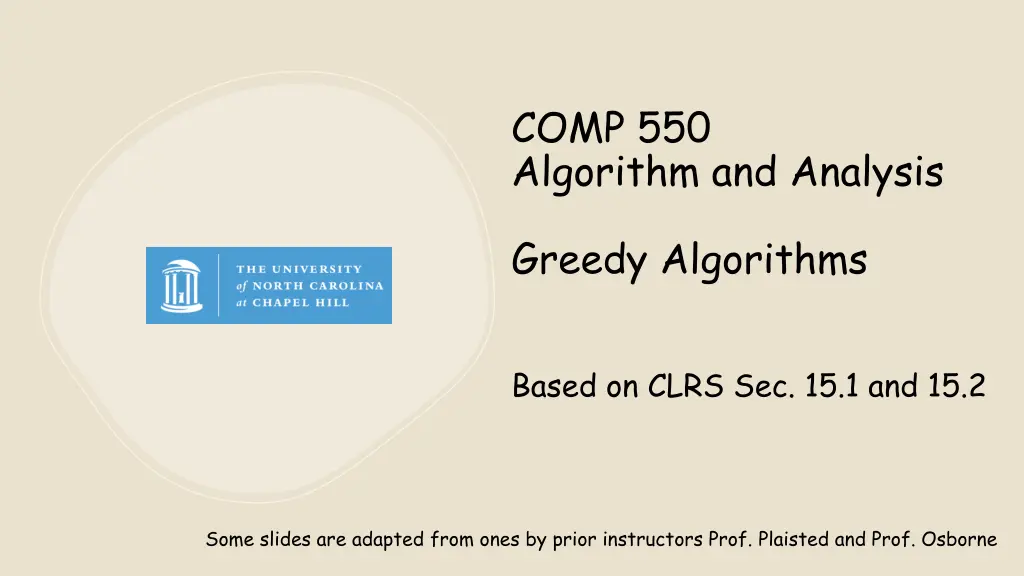
Greedy Algorithms: Understanding Coin Change and Optimal Substructure
Explore the concept of greedy algorithms through the lens of coin change problems, delving into optimal substructure properties and strategies for finding globally optimal solutions. Examples and explanations from COMP.550 Algorithm and Analysis course slides by Prof. Plaisted and Prof. Osborne are used to illustrate these concepts.
Download Presentation

Please find below an Image/Link to download the presentation.
The content on the website is provided AS IS for your information and personal use only. It may not be sold, licensed, or shared on other websites without obtaining consent from the author. If you encounter any issues during the download, it is possible that the publisher has removed the file from their server.
You are allowed to download the files provided on this website for personal or commercial use, subject to the condition that they are used lawfully. All files are the property of their respective owners.
The content on the website is provided AS IS for your information and personal use only. It may not be sold, licensed, or shared on other websites without obtaining consent from the author.
E N D
Presentation Transcript
COMP 550 Algorithm and Analysis Greedy Algorithms Based on CLRS Sec. 15.1 and 15.2 Some slides are adapted from ones by prior instructors Prof. Plaisted and Prof. Osborne
Coin Change You have unlimited quantities of pennies (1 cent), nickels (5 cents), dimes (10 cents), and quarters (25 cents) And there is one new coin denominations: 26 cents How to provide change of 61 cents? Coin Number Fictitious (26 ) Quarters (25 ) Dimes (10 ) Nickels (5 ) Pennies (1 ) COMP550@UNC 2
Coin Change You have unlimited quantities of pennies (1 cent), nickels (5 cents), dimes (10 cents), and quarters (25 cents) And there is one new coin denominations: 26 cents How to provide change of 61 cents? Coin Greedy 2 (52 ) 0 (0 ) 0 (0 ) 1 (5 ) 4 (4 ) Optimal 1 (26 ) 1 (25 ) 1 (10 ) 0 (0 ) 0 (1 ) Fictitious (26 ) Quarters (25 ) Dimes (10 ) Nickels (5 ) Pennies (1 ) COMP550@UNC 3
Coin Change Greedy doesn t work here The optimal solution is < 26 , 25 ,10 > Does this solution still have the optimal substructure property? Optimal solution for change of 35 ? < 25 ,10 > Optimal solution for change of 36 ? < 26 ,10 > COMP550@UNC 4
Coin Change You have unlimited quantities of pennies (1 cent), nickels (5 cents), dimes (10 cents), quarters (25 cents), and fictitious (26 cents) Provide change of ? cents using minimum number of coins. Let COMP550@UNC 5
Greedy Algorithm for Coin Change Input: A list of coins ?, and a ?????? Output: List of coins that equals ?????? Coin-Change(C, target) 1. Let A be an empty list 2. Sort C in descending order (not needed if presorted) 3. return Recursive-Coin-Change(C, A, target) Recursive-Coin-Change(C, A, target) 1. c = C[1] //largest coin in C 2. if (c target) 3. A.append(c) 4. return Recursive-Coin-Change(C, A, target-c) 5. else 6. return Recursive-Coin-Change(C.remove(c), A, target) COMP550@UNC 6
Greedy Strategies The choice that seems best at the moment is the one we pick Locally optimal choice leads to a globally optimal solution This strategy will work if The problem has optimal substructure property There is a greedy choice with greedy-choice property COMP550@UNC 7
Optimal Substructure Optimal substructure property Optimal solution of a problem contains optimal solutions of its subproblems Does coin change problem has optimal substructure property? Optimal solution for change of 61 was < 25 , 25 ,10 ,1 > What is the optimal solution for 36 ? < 25 ,10 ,1 > COMP550@UNC 8
Greedy-Choice Property Greedy-Choice Property An item picked by a greedy choice is guaranteed be in an optimal solution Does the coin change problem satisfy greedy-choice property? The largest coin less than or equal to target value is part of an optimal solution If target is 61 , then there is an optimal solution with at least one 25 COMP550@UNC 9
Activity-Selection Problem Also known as Interval Scheduling problem Input: Set S of n activities, ?1,?2, ,??. ?? = start time of activity i. ?? = finish time of activity i. Activity ??takes place during [??,??) Output: Subset Aof maximum number of compatible activities. Two activities are compatible, if their intervals don t overlap. Activities in each line are compatible. Example: COMP550@UNC 10
Activity-Selection Problem 1 2 3 4 5 1 3 0 5 3 4 5 6 7 8 6 5 9 7 6 10 8 8 11 9 8 12 10 2 13 11 12 14 ? Example: ?? ?? ?? ?? ?? ?? ?? ?? ?? ?? ?? ??? ??? 0 1 2 3 4 5 6 7 8 9 10 11 12 13 COMP550@UNC 11
Activity-Selection Problem 1 2 3 4 5 1 3 0 5 3 4 5 6 7 8 6 5 9 7 6 10 8 8 11 9 8 12 10 2 13 11 12 14 ? Example: ?? ?? ?? ?? ?? ?? ?? ?? ?? ?? ?? ??? ??? One solution: {?3,?9,?11} Here, solution means the set satisfies constraints of the problem, each pair in {?3,?9,?11} are compatible 0 1 2 3 4 5 6 7 8 9 10 11 12 13 COMP550@UNC 12
Activity-Selection Problem 1 2 3 4 5 1 3 0 5 3 4 5 6 7 8 6 5 9 7 6 10 8 8 11 9 8 12 10 2 13 11 12 14 ? Example: ?? ?? ?? ?? ?? ?? ?? ?? ?? ?? ?? ??? ??? Another solution: {?1,?4,?8,?11} Is there a larger set? No, this is an optimal solution 0 1 2 3 4 5 6 7 8 9 10 11 12 13 COMP550@UNC 13
Activity-Selection Problem 1 2 3 4 5 1 3 0 5 3 4 5 6 7 8 6 5 9 7 6 10 8 8 11 9 8 12 10 2 13 11 12 14 ? Example: ?? ?? ?? ?? ?? ?? ?? ?? ?? ?? ?? ??? ??? Another optimal solution: {?2,?4,?9,?11} 0 1 2 3 4 5 6 7 8 9 10 11 12 13 COMP550@UNC 14
Activity-Selection Problem What should a greedy algorithm look like for this problem? Iterative-Activity-Selection(S) 1. A = an empty list (to store result) 2. while (S ) 3. a = An activity from S according to a greedy choice 4. A = A { a } 5. Sa = all activities in S that overlap with a 6. S = S \ Sa 7. return A Recursive-Activity-Selection(S) 1. If S = 2. return 3. a = An activity from S according to a greedy choice 4. Sa = all activities in S that overlap with a (including a) 5. return Recursive-Activity- Selection(S \ Sa) { a } COMP550@UNC 15
Activity-Selection Problem Can we figure out a greedy choice (leading to an optimal solution)? Recall: For greedy algorithm to work, item picked by greedy choice must be part of an optimal solution Option 1: Shortest interval (pick the shortest interval that does not overlap with previously-selected intervals) Question: Does it lead to an optimal solution? COMP550@UNC 16
Activity-Selection Problem Option 1: Shortest interval (pick the shortest interval that does not overlap with previously-selected intervals) Question: Does it lead to an optimal solution? Proof of non-optimality 5 1 4 7 11 6 [4,7) is the shortest interval. If [4,7) is picked, none other can be picked [1,5) and [6,11) is optimal subset of activities. COMP550@UNC 17
Activity-Selection Problem Option 2: Least number of conflicts (pick the activity that does not overlap with the least) Non-optimal (Can you give an example showing this?) Option 3: Earliest start time (pick the earliest-starting activity) Non-optimal (Can you give an example showing this?) Option 4: Earliest finish time (pick the earliest-finishing activity) Optimal COMP550@UNC 18
Why Earliest Finish Time Works? Need to argue that Earliest Finish Time satisfies greedy-choice property An activity picked by earliest-finish-time greedy choice is always in an optimal solution. Can you write a theorem statement for this? Theorem 15.1. Consider any non-empty set of activities ??. Let ?? be an activity in ?? with the earliest finish time. Then, ?? is included in some maximum subset of mutually compatible activities in ?? (In other words, ??is included in an optimal solution). COMP550@UNC 19
Why Earliest Finish Time Works? Theorem 15.1. Consider any non-empty set of activities ??. Let ?? be an activity in ?? with the earliest finish time. Then, ?? is included in some maximum subset of mutually compatible activities in ??. Proof by exchange argument. Key idea: My solution is no worse than yours Exchanging an item from an arbitrary optimal solution with your greedy choice makes the new solution no worse COMP550@UNC 20
Why Earliest Finish Time Works? Theorem 15.1. Consider any non-empty set of activities ??. Let ?? be an activity in ?? with the earliest finish time. Then, ?? is included in some maximum subset of mutually compatible activities in ??. Proof by exchange argument. Let ??? be a maximum subset of mutually compatible activities. ?? ??? ?? Let ?? be the activity in OPT with the earliest finish time, i.e., among all activities in OPT, ?? has the earliest finish time. If ??= ??, we are done. So, assume ?? ??. COMP550@UNC 21
Why Earliest Finish Time Works? Theorem 15.1. Consider any non-empty set of activities ??. Let ?? be an activity in ?? with the earliest finish time. Then, ?? is included in some maximum subset of mutually compatible activities in ??. Proof by exchange argument. Activities in ??? other than ??must start after ?? ends. ?? ??? ?? Since ?? ??,?? does not overlap with activities in ??? ?? So, we can exchange ?? with ?? and create a new subset ?? ??? {??} of mutually compatible activities. ??? = ??? ?? ?? |??? | = OPT . 22 COMP550@UNC
Optimal Substructure Let ?? be the activity with the earliest finish time and ?? be the set of activities that overlap with ? (including ?). Then, optimal solution for ?= ?? optimal solution for ?\S? Proof by contradiction. Let ? be a solution for ? by taking ?? optimal solution for ?\S?. For contradiction, assume ? is not optimal. Let ??? be an optimal solution for ? that includes ??. By Theorem 15.1 (greedy-choice property), such an optimal solution exists. Remove {??} from ???. This ??? {??} should be larger than the optimal solution for ?\S?, contradiction. 23 COMP550@UNC
Greedy Algorithm for Activity Selection Iterative-Activity-Selection(S) 1. Sort S be ?? values 2. A = {?1} 3. k = 1 //k denotes index of the last selected activity 4. for (i = 2 to ?) 5. if (fk <= si) 6. A = A {?i} 7. k = i 8. return A Correctness: Immediate from greedy-choice and optimal substructure properties Running time: (?lg?) If input array ? is pre-sorted by finish time, then (?) 24 COMP550@UNC
Another Optimality Proof Theorem. The algorithm returns a largest subset of compatible activities. Proof Sketch: Let ?????? be our solution. Assume ?????? is not optimal Assume ?????? = ?1,?2, ,?? Assume ??? = ?1,?2, ,?? is an optimal solution with activities such that ?1= ?1,?2= ?2, ,?? 1= ?? 1,?? ?? holds with largest ? value. There can be many optimal solution, we took the one that has the most consecutive matching with ?????? from the first selected activity ?1 ?2 ?? 1 ?? ?????? ??? ?1 ?2 ?? 1 ?? 25 COMP550@UNC
Another Optimality Proof Theorem. The algorithm returns a largest subset of compatible activities. Proof Sketch: Let ?????? is our solution and ??? is an optimal solution. Case 1: ? > ?. Then, ?? does not exist, but greedy algorithm would pick another activity (e.g., it could pick ?? without causing overlaps) Case 2: ? ?. Exchange ??with ?? in ??? (As we did in Theorem 15.1). The new OPT shows that the old OPT does not have the largest r value, contradiction. ?1 ?2 ?? 1 ?? ?????? ??? ?1 ?2 ?? 1 ?? 26 COMP550@UNC
Yet Another Optimality Proof Theorem. The algorithm returns a largest subset of compatible activities. The previous proof is based on exchange argument Another technique to prove optimality of greedy algorithms: Greedy Stays Ahead Show that, for all i, the ?? activity by Greedy has earlier finish time than the ?? choice of an arbitrary optimal solution 27 COMP550@UNC
Thank You! COMP550@UNC 28

